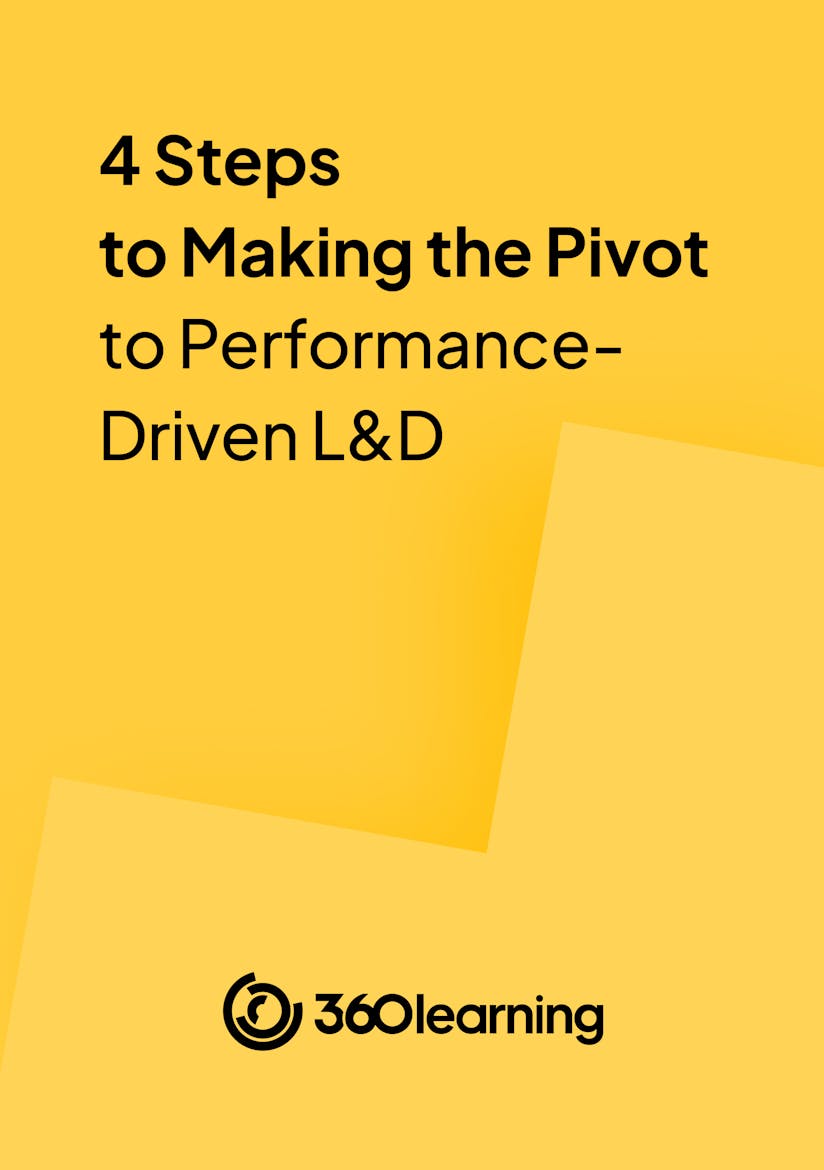
Most L&D professionals struggle with the fact that no one in our organizations actually understands what our function does in the day-to-day.
So, how can we quickly show how our upskilling initiatives impacts the pain points of our organization in a way that engages and convinces our stakeholders of our function’s worth?
In this article, we explore key takeaways from Neil John Cunningham’s latest book, Numbers & Narratives, and how to prove the value of learning and development. We discuss recognizing the commercial power of L&D, Neil’s data storytelling approach, and his five steps for calculating the numbers to show return on investment (ROI).
Listen to this episode🎙️ Numbers & Narratives: 7 Steps to Proving L&D Value with Neil John Cunningham

Impactful, demonstrable L&D in 4 simple steps
By providing your contact info, you agree to receive communications from 360Learning. You can opt-out at any time. For details, refer to our Privacy Policy.
Recognizing the commercial power of L&D
If L&D doesn’t recognize that financials are critical to our stakeholders, we miss a massive opportunity to demonstrate our commercial alignment with business needs.
In most organizations, L&D is a separate function that is reported as a cost to the business. The good news is that once you understand what the function costs the organization, you can pivot to how you can help the company grow or retain customers, which will have a monetary value.
“At the end of the day, businesses exist to make money. If you’re not helping to grow the business, there is going to be a big question mark above the L&D function,” says Neil.
“At the end of the day, businesses exist to make money. If you’re not helping to grow the business, there is going to be a big question mark above the L&D function,” - Neil John Cunningham
To start showing that you and your team are thinking about the organization’s business needs, be honest about what L&D can do to solve real business problems. By talking business with your stakeholders, you will uncover what keeps them up at night and can then start working to solve those pain points, which will be measurable.
The hero’s journey: Telling the data story
Over the years, Neil has found that people love a story, which is the inspiration behind his Numbers and Narratives model for proving L&D value.
The hero's journey is a twelve-step version of the monomyth, applied to best-selling novels such as The Hunger Games. In his book, Neil refines the hero’s journey into seven steps to help you grab your stakeholders’ attention and tell them how your upskilling initiative helped employees and improved business performance.
“The model helps people understand what L&D does, how much hard work goes into it, how you have changed the business for the better, and what you plan to do next,” says Neil.
“The model helps people understand what L&D does, how much hard work goes into it, how you have changed the business for the better, and what you plan to do next."
What makes the model work is that from the genesis of a training request or stakeholder meeting, you are setting out the start of the journey (the real business problem) and how the quest will end (measuring and proving the value).
Five steps for calculating the numbers
The data story empowers you and your team to show your stakeholders how you impacted business problems in a way they can understand.
Here are Neil’s five steps for calculating the numbers to prove the impact of your upskilling initiatives.
Step 1: Where are we now?
First, you need to identify the current state of the business. In Neil’s model, the data and desire are the call to adventure part of the hero’s journey.
“Someone in the business will have a desire to change something, and they will have some data to back up that change,” says Neil.
For example, a business made 100 sales a week a year ago, but now it’s only making 50. The data is the difference in sales, and the desire is to return to previous sales numbers.
Step 2: Where are we going?
Next, you need to investigate the business problem and create your hypothesis.
Continuing our sales example, you’ve looked at the sales funnel and see that people are dropping off at the demo stage of the product. By listening to the calls, you find that the sales team isn’t handling the product objections.
In this scenario, the hypothesis is: If we give this group objection handling skills and they practice those, they will be able to move customers into the next step of the sales pipeline.
Step 3: Identify organizational blockers
In this step, you need to identify if any other factors are stopping people from closing those sales. These are the organizational blockers.
“You need to make sure what you are building out is fit for purpose and build a pilot to create a static environment to prove that the performance improvement is a direct cause of the learning provided,” says Neil.
“Make sure what you are building is fit for purpose and build a pilot to create a static environment to prove that the performance improvement is a direct cause of the learning provided."
Step 4: Set your learning objectives
Next, break down your hypothesis into learning objectives and clarify how those will change behaviors.
“This step is so we can show what we expected people to learn, how they learned it, and how we adapted to people’s styles or accessibility needs,” says Neil.
Step 5: Measure performance outcomes
Finally, you measure the performance outcomes of your upskilling initiatives.
For example, if the test group makes eight sales a week instead of five, that's an improvement of 12 monthly sales. This increase has a monetary value, which is your ROI.
Tips to get started telling your own data story
If you want to start leveraging the data story approach, consider these tips (as well as getting a copy of Neil’s book).
1. Don’t try to understand the data in a vacuum: Reach out for help. There will be people in the business who understand those datasets and will be able to explain them to you in simple terms.
2. Self-reflection for the L&D team: Review a past program and consider what you would have done differently if you were to apply the Narrative and Numbers model.
3. Apply the model to a small existing program: See if you can apply Neil’s model to a current program, or if you have one coming up, see if you have the bandwidth to test it out on a pilot group before the program launches properly.
Explore further insights on telling the data story on the episode of The L&D Podcast: Numbers & Narratives: 7 Steps to Proving L&D Value with Neil John Cunningham
Want more peer insights on transforming workplace learning? Sign up to become a member of the L&D Collective. Or you can subscribe below to our weekly newsletter to receive our latest posts directly in your inbox.




